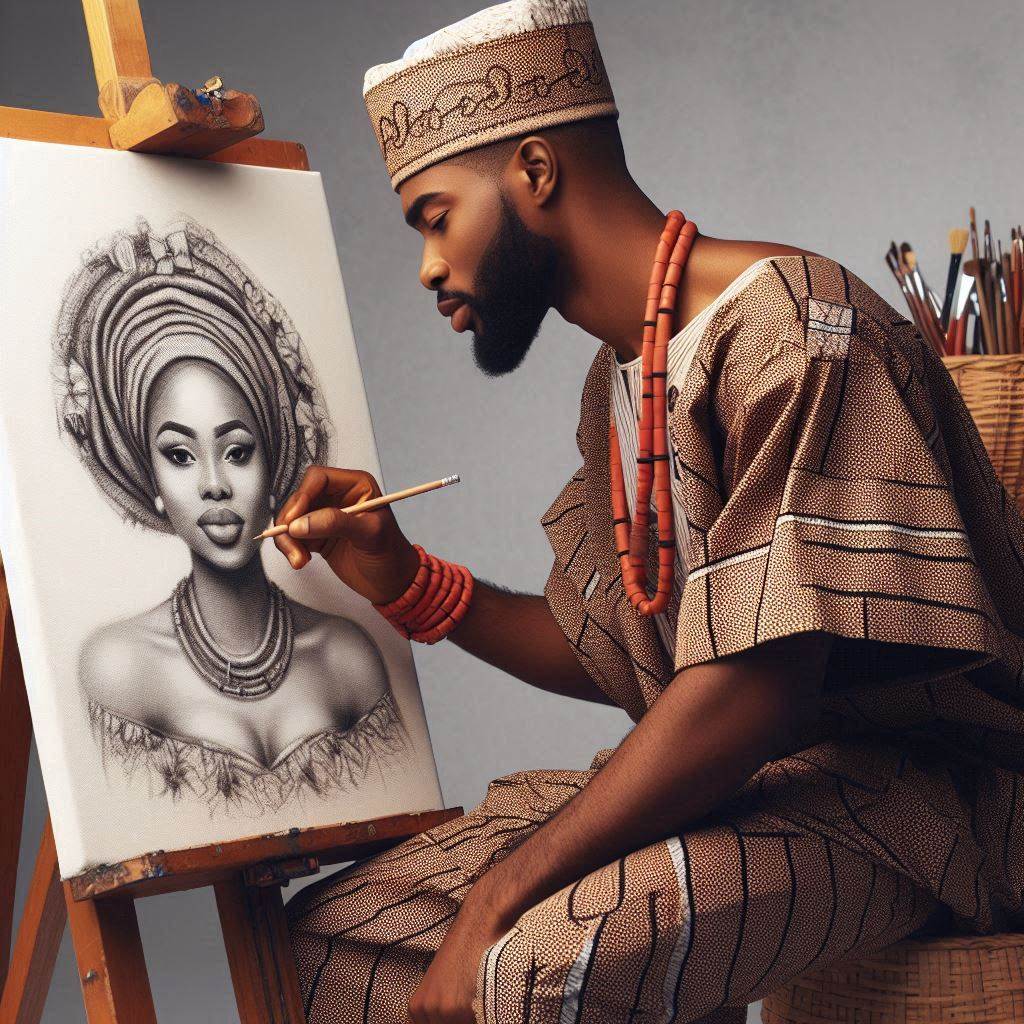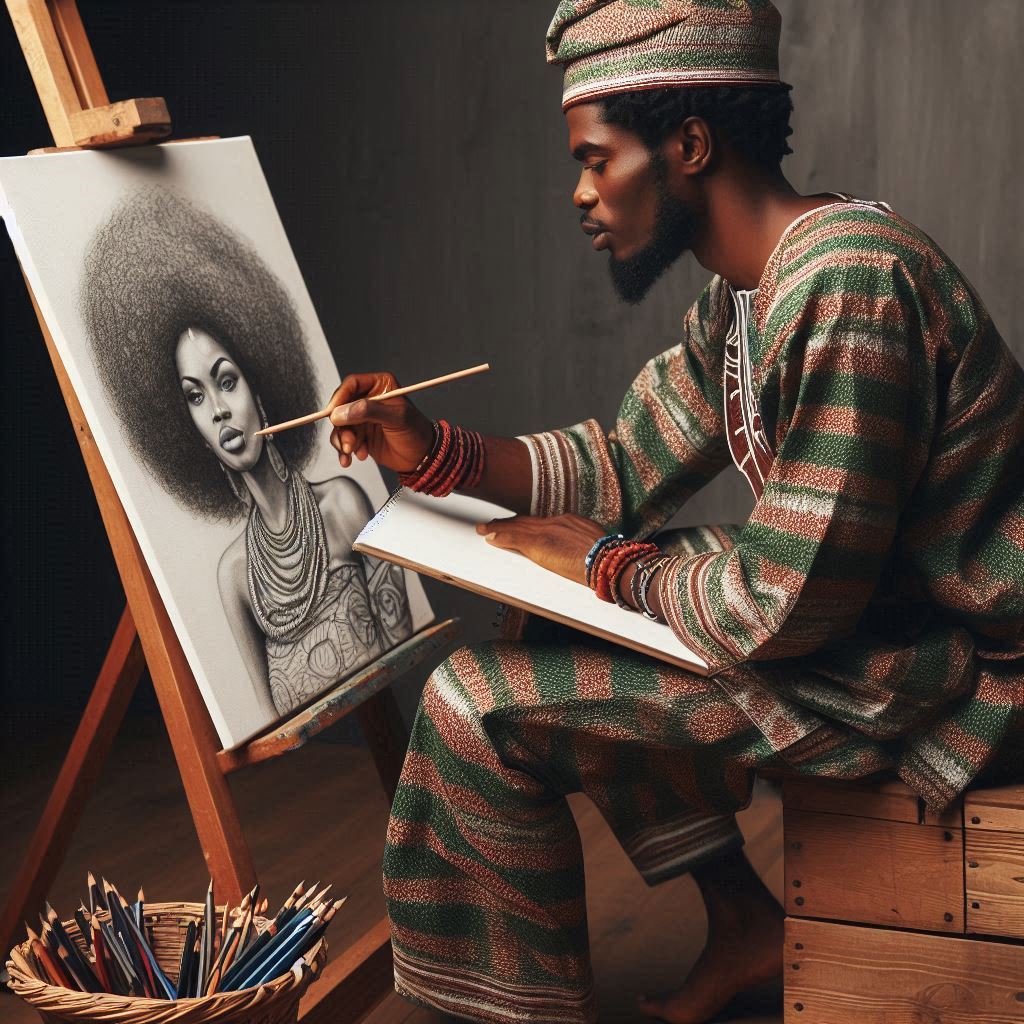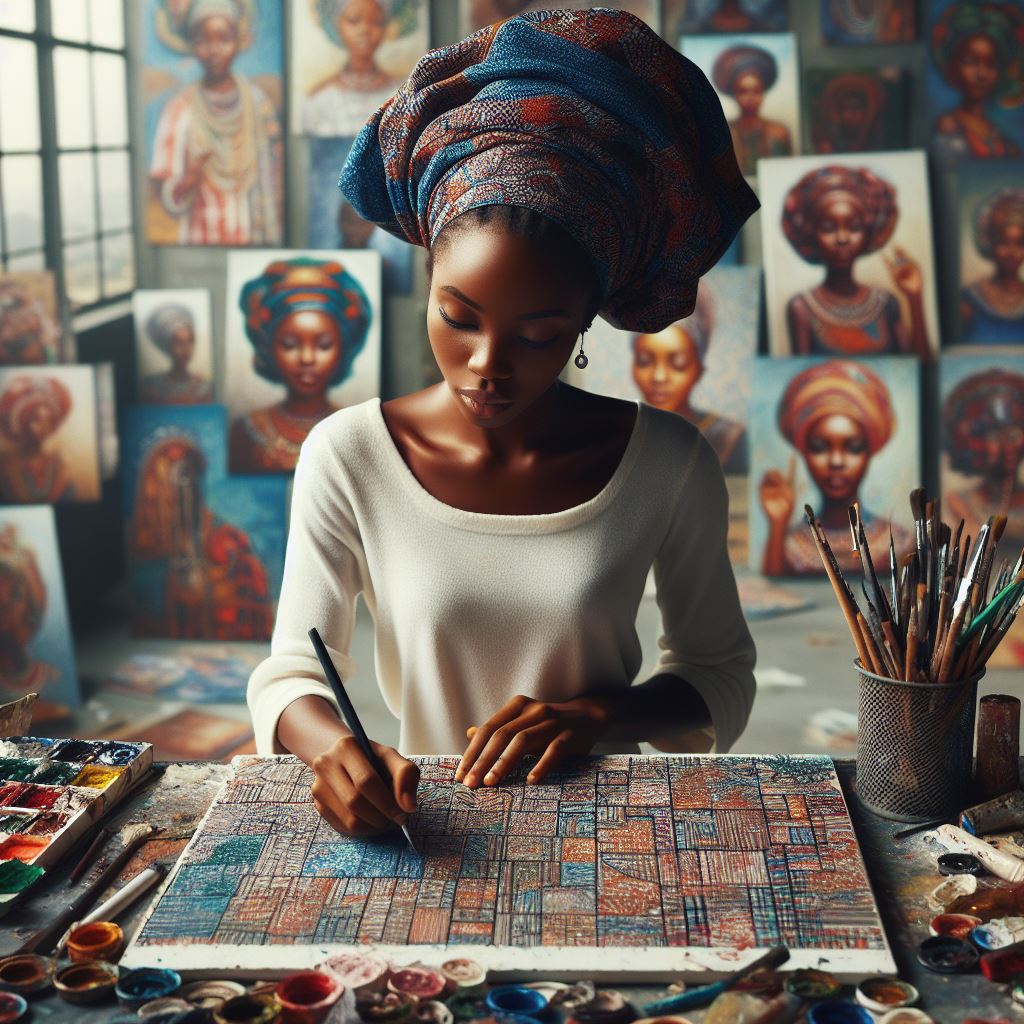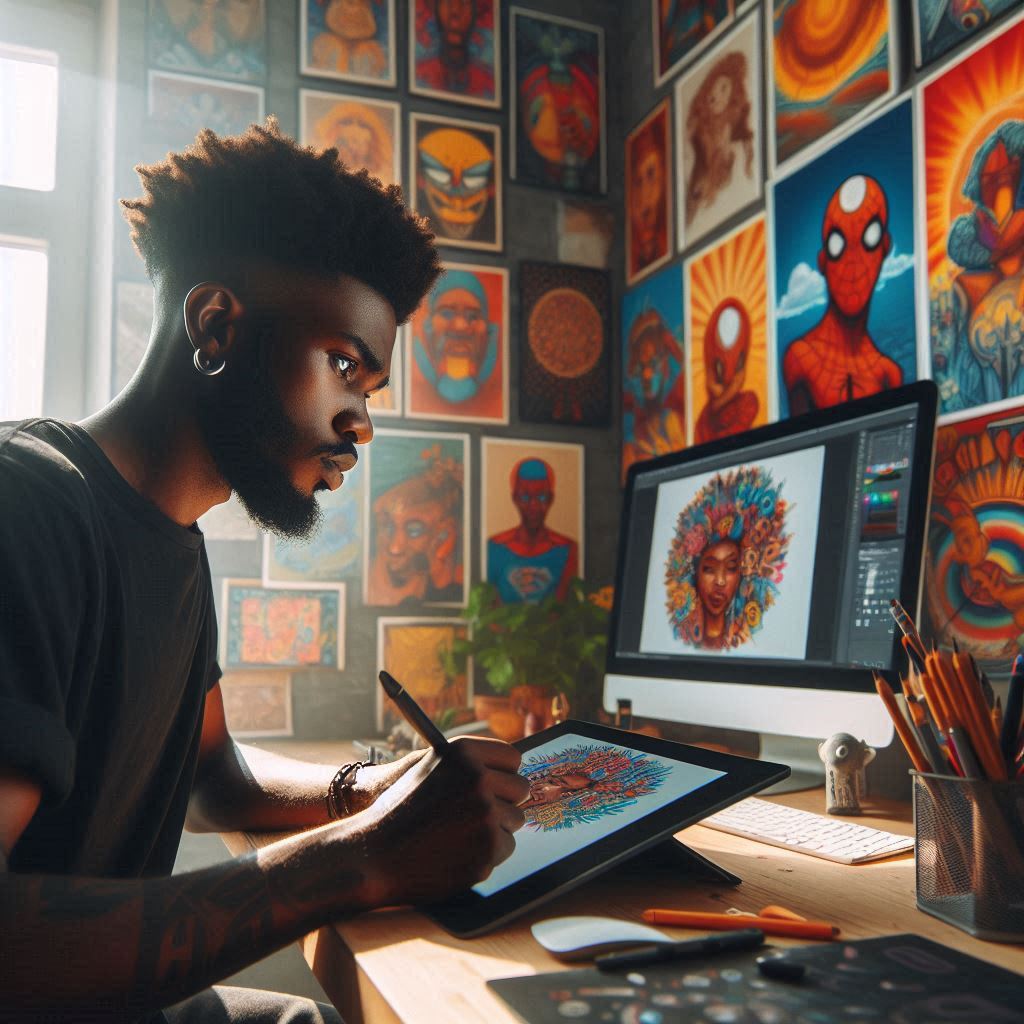Introduction
Art has always been a form of expression that captivates and inspires individuals.
Starting a career in Fine and Applied Art opens up a world of endless possibilities and opportunities for creative minds.
With the rise of digital platforms and the growing demand for unique and original artwork, the field of Fine and Applied Art has seen a surge in popularity.
Importance and Potential Opportunities
The importance of Fine and Applied Art lies in its ability to evoke emotions, challenge perceptions, and create meaningful connections with the audience.
Additionally, the potential opportunities in this field are vast, ranging from working as an artist in galleries, museums, or studios, to freelancing and collaborating with brands and companies for commissioned projects.
With the advent of social media and online marketplaces, artists now have a global platform to showcase their work and reach a wider audience.
Significance of Creativity and Passion
Creativity and passion are the driving forces behind a successful career in Fine and Applied Art.
Artists must possess a strong sense of creativity to create original and innovative pieces that resonate with viewers.
Passion fuels the artist’s dedication and commitment to their craft, pushing them to continuously improve and evolve as an artist.
Without creativity and passion, an artist may struggle to stand out in a highly competitive industry..
Research and Self-Assessment
Different specializations within Fine and Applied Art
When starting a career in Fine and Applied Art, it is essential to begin with thorough research.
This involves exploring the various specializations within the field to determine which area aligns with your interests and skills.
Whether it’s painting, sculpture, graphic design, or fashion design, understanding the different options available will help you make an informed decision about your career path.
Assess your strengths, weaknesses, interests, and goals
In addition to exploring different specializations, conducting a self-assessment is crucial.
Take the time to evaluate your strengths and weaknesses, as well as your interests and long-term goals.
By understanding what you excel at and what areas you need to improve on, you can better tailor your career path to suit your capabilities and aspirations.
Research educational programs and institutions that offer relevant courses
Research plays a significant role in shaping your career trajectory.
Look into educational programs and institutions that offer courses relevant to your chosen specialization.
Consider factors such as the curriculum, faculty expertise, facilities, and opportunities for internships or practical experience.
Choosing the right educational environment can provide you with the knowledge and skills needed to succeed in the competitive field of Fine and Applied Art.
Whether you opt for a traditional art school, a university with a strong Fine Arts program, or online courses, it is crucial to select a program that best fits your learning style and career goals.
Take the time to visit campuses, attend open houses, and speak with current students and faculty members to gain a better understanding of what each program entails.
Ultimately, the research and self-assessment phase is all about laying a solid foundation for your career in Fine and Applied Art.
By taking the time to explore different specializations, evaluate your strengths and weaknesses, and research educational opportunities, you can set yourself up for success in this creative and rewarding field.
Read: Student Experiences: Life in Communication Arts
Gain Education and Skills
To start a career in fine and applied art, one of the essential steps is to gain the necessary education and skills required to succeed in this field.
Whether you are interested in fine arts, graphic design, illustration, or any other art form, acquiring the right education and honing your skills is crucial.
Pursue Formal Education
When it comes to formal education, consider enrolling in programs related to the specific art discipline you want to pursue.
Fine arts programs offer a comprehensive curriculum covering various mediums, techniques, art history, and theory.
On the other hand, graphic design or illustration programs focus on digital art, visual communication, and design principles.
Choose a program that aligns with your interests and career goals.
Develop Technical Skills
In addition to formal education, it is essential to develop technical skills through constant practice and hands-on experience.
Take advantage of workshops, classes, and online tutorials to enhance your abilities in areas such as painting, drawing, digital design, photography, or sculpture.
The more proficient you become in your craft, the more versatile and competitive you will be as an artist.
Build a Portfolio
A well-curated portfolio is your professional showcase to potential clients, employers, and galleries.
Include a diverse range of your best work that demonstrates your artistic abilities, style, and creativity.
Your portfolio should highlight your unique voice as an artist and showcase your versatility across different mediums and projects.
Continuously update and refine your portfolio as you create new pieces and gain more experience in the field.
By gaining the necessary education and skills, you will establish a strong foundation for your career in fine and applied art.
Remember that artistic growth is a lifelong journey, so stay committed to learning, experimenting, and pushing your creative boundaries.
With dedication and perseverance, you can build a successful and fulfilling career as an artist.
Read: Communication Arts: Balancing Theory and Practice
Networking and Building Connections
Attend Art Exhibitions, Workshops, and Industry Events
Starting a career in fine and applied art requires active engagement with the art community.
Attending art exhibitions, workshops, and industry events is essential.
These venues provide exposure to various art forms and current trends. By observing diverse artworks, you can refine your artistic style and technique.
Workshops offer hands-on experience and direct learning from established artists.
Participating in these sessions helps you develop new skills and techniques.
Industry events, such as art fairs and conferences, present opportunities to network with art professionals.
These connections can lead to mentorship and career opportunities.
Engaging in these events also enhances your understanding of the art market. You learn what types of work are in demand and how to price your pieces.
This knowledge is crucial for building a successful career in art.
Connect with Fellow Artists, Mentors, and Professionals in the Field
Building a network of fellow artists, mentors, and professionals is vital.
Relationships within the art community provide support, inspiration, and opportunities. Start by connecting with artists whose work you admire.
Reach out to them during exhibitions or through social media platforms.
Mentorship is a valuable resource for emerging artists.
Experienced artists can provide guidance, critique your work, and offer career advice.
Don’t hesitate to ask for mentorship or join artist groups where mentorship is available.
Professionals in the field, such as gallery owners, curators, and art critics, can also be instrumental.
Building relationships with these individuals can lead to exhibition opportunities and press coverage.
Attend gallery openings and industry talks to meet and connect with these professionals.
Join Online Platforms and Artist Communities to Share Your Work and Gain Exposure
In the digital age, online platforms are crucial for artists.
Join platforms like Instagram, Behance, and DeviantArt to showcase your work.
These platforms allow you to reach a global audience and attract potential buyers and collaborators.
Engage with other artists on these platforms by commenting on and sharing their work.
This interaction helps build a supportive community and increases your visibility.
Consistently update your profiles with new work and projects to maintain interest.
Joining online artist communities and forums is also beneficial.
Sites like Reddit and specialized art forums offer spaces for critique and discussion.
Participating in these communities provides valuable feedback and new perspectives on your work.
Additionally, having a personal website is essential for a professional online presence.
Your website should include a portfolio, artist statement, and contact information.
This site serves as a central hub for galleries, buyers, and other professionals to view your work.
Starting a career in fine and applied art involves active participation in the art community.
Attend art exhibitions, workshops, and industry events to gain exposure and knowledge.
Connect with fellow artists, mentors, and professionals to build a supportive network.
Join online platforms and artist communities to share your work and gain global exposure.
By following these steps, you can build a successful and fulfilling career in the art world.
Read: How to Apply for Communication Arts Programs

Internships and Apprenticeships
Seek Internships or Apprenticeships with Established Artists or Organizations
Starting a career in fine and applied art requires hands-on experience.
Seeking internships or apprenticeships with established artists or organizations is essential.
These opportunities provide invaluable learning experiences and insights into the industry.
Working under established artists allows you to observe their creative processes and business practices.
Internships with art organizations, such as galleries or museums, offer a different perspective.
They expose you to the administrative and curatorial aspects of the art world.
This experience is beneficial for understanding how the industry operates beyond the studio.
Gain Practical Experience and Insights into the Industry
Practical experience is crucial for developing your skills and understanding the art market.
Internships and apprenticeships provide this experience in a real-world setting.
You learn how to manage projects, meet deadlines, and interact with clients or collectors.
This hands-on training is invaluable for building a successful art career.
Additionally, these positions often involve tasks that you might not encounter in a classroom.
You gain insights into the logistical aspects of creating and selling art.
This knowledge helps you navigate the complexities of the art industry more effectively.
Learn from Professionals and Expand Your Skills
Learning from professionals in the field is one of the most significant benefits of internships and apprenticeships.
Established artists and art professionals offer mentorship and guidance.
They provide feedback on your work, helping you improve your technique and conceptual approach.
These mentors can also introduce you to new materials, tools, and methods.
Exposure to different styles and practices broadens your artistic repertoire.
This diversity in skills and techniques makes you a more versatile and adaptable artist.
Moreover, the relationships you build during these experiences can lead to future opportunities.
Networking with professionals and fellow interns can open doors to exhibitions, collaborations, and job offers.
The connections you make are as valuable as the skills you learn.
Starting a career in fine and applied art involves gaining practical experience and learning from established professionals.
Seek internships or apprenticeships with established artists or organizations to immerse yourself in the industry.
These opportunities provide hands-on experience and insights that are crucial for your development.
Learn from professionals to expand your skills and build a supportive network.
By following these steps, you can set a strong foundation for a successful career in the art world.
Read: Famous Nigerian Alumni of Communication Arts Programs
Freelancing and Building a Brand
Freelancing is a great way to kickstart your career in fine and applied art. It allows you to gain practical experience while building a client base.
Start freelancing to gain experience and create a client base
- Offer your services to friends, family, and local businesses to get your foot in the door.
- Take on small projects or commissions to showcase your skills and build a portfolio.
- Network with other artists and professionals in the industry to expand your opportunities.
Establish your unique style and brand identity
- Identify what sets your art apart from others and use it to define your artistic identity.
- Experiment with different techniques, mediums, and styles to further develop your unique voice.
- Consistency is key – strive to create a cohesive body of work that reflects your style and vision.
Market yourself through social media, online platforms, and art shows
- Utilize social media platforms like Instagram, Facebook, and Twitter to showcase your work and connect with potential clients.
- Create a professional website or online portfolio to display your artwork and provide contact information for inquiries.
- Participate in local art shows, exhibitions, and craft fairs to gain exposure and reach a wider audience.
By freelancing and building a strong brand, you are not only honing your skills as an artist but also establishing yourself as a reputable and recognizable presence in the art world.
Read: Digital Media Trends in Communication Arts
Continuous Learning and Adaptation
Stay Updated on Trends, Techniques, and Technology in the Art Industry
Starting a career in fine and applied art requires staying current with industry trends, techniques, and technology.
The art world is dynamic and ever-changing. Regularly updating your knowledge ensures you remain relevant and competitive.
Follow art publications, blogs, and social media to keep track of emerging trends and innovations.
Technology is particularly influential in modern art practices. Familiarize yourself with the latest digital tools and software.
These advancements can enhance your creative process and expand your artistic capabilities.
Staying informed about new techniques and methods helps you to innovate and differentiate your work.
Take Courses, Attend Workshops, and Seek Feedback from Peers
Continuous learning is essential for artistic growth and career advancement.
Enroll in courses and attend workshops to develop new skills and techniques.
These educational opportunities provide structured learning environments and access to expert instruction.
They also offer a chance to experiment with different mediums and styles.
Seeking feedback from peers is equally important.
Constructive criticism helps you improve and refine your work.
Join critique groups or art communities where you can share your work and receive feedback.
This interaction fosters growth and provides new perspectives on your art.
Workshops and courses also provide networking opportunities.
Meeting other artists and industry professionals can lead to collaborations and new opportunities.
Building a community around your practice is crucial for support and inspiration.
Adapt to Changes and Challenges in the Market to Stay Competitive
The art market is constantly evolving, and adaptability is key to success.
Stay informed about market trends and changes in consumer preferences.
This knowledge allows you to tailor your work to meet current demands.
Flexibility in your approach can open up new avenues for your art practice.
Facing challenges head-on and adapting to them is essential.
Economic fluctuations, shifting tastes, and technological advancements can all impact the art market.
Developing resilience and a proactive mindset helps you navigate these challenges effectively.
Transform Your Career with Expert Guidance
Get personalized mentorship consulting that’s tailored to your unique path. Our expert advice is actionable and exclusive.
Get StartedAdapting your business strategies is also important.
Embrace online platforms and social media to reach a broader audience.
Create an online portfolio and engage with potential buyers and collaborators digitally.
This adaptability ensures you remain visible and relevant in a competitive market.
Starting a career in fine and applied art involves continuous learning and adaptability.
Stay updated on trends, techniques, and technology to remain relevant.
Take courses, attend workshops, and seek feedback from peers to enhance your skills.
Adapt to changes and challenges in the market to stay competitive.
By following these steps, you can build a resilient and successful art career.
Embrace the dynamic nature of the art world and position yourself for long-term success.
Seek Mentorship and Guidance
Find a Mentor or Coach Who Can Provide Guidance and Support
Starting a career in fine and applied art requires guidance and support.
Finding a mentor or coach can be incredibly beneficial. Mentors offer valuable insights and help you navigate the complexities of the art industry.
They provide support, encouragement, and constructive feedback.
A mentor can be an established artist, a professor, or an industry professional. Look for someone whose work you admire and who shares your artistic values.
Approach them with respect and genuine interest in learning from their experiences. Many experienced artists are willing to mentor emerging talents.
Learn from Their Experiences and Advice on Navigating the Industry
Mentors share their experiences, offering practical advice on how to succeed in the art world.
hey can guide you through common challenges and help you avoid pitfalls.
Learning from their successes and mistakes provides a roadmap for your own career.
Mentors can offer insights into the business side of art, such as pricing, marketing, and networking.
They can also help you understand how to get your work into galleries and exhibitions.
Their advice is invaluable for building a sustainable and successful art practice.
Regular meetings or communications with your mentor ensure ongoing support and learning.
Be open to their feedback and willing to apply their advice to your work and career strategies.
Build a Professional Relationship That Can Help You Grow and Succeed
Building a professional relationship with your mentor is key to long-term growth.
Treat this relationship with respect and professionalism.
Show appreciation for their time and input, and demonstrate your commitment to improving and learning.
A strong mentor-mentee relationship can open doors to new opportunities.
Your mentor can introduce you to other professionals, recommend you for exhibitions, or help you gain access to resources.
They can also provide letters of recommendation and endorsements.
This relationship can also evolve over time.
As you grow and succeed, you may become a peer and collaborator with your mentor.
This ongoing professional connection can be mutually beneficial and lead to further opportunities.
Starting a career in fine and applied art involves finding guidance and support from experienced mentors.
Seek out a mentor or coach who can offer valuable insights and advice.
Learn from their experiences to navigate the art industry effectively.
Build a professional relationship that fosters growth and success.
By following these steps, you can enhance your artistic development and increase your chances of a successful career.
Embrace the opportunity to learn from those who have walked the path before you and build a solid foundation for your future in the art world.
Conclusion
Starting a career in fine and applied art requires dedication and proactive steps.
Begin by attending exhibitions, workshops, and industry events to gain exposure and insights.
These experiences help you understand current trends and techniques in the art world.
Connect with fellow artists and mentors for support and guidance, as these relationships can be invaluable for your growth and opportunities.
Join online platforms and artist communities to share your work and reach a global audience.
Engage with other artists and participate in discussions to gain feedback and improve your skills.
The internet is a powerful tool for building your portfolio and expanding your network.
Dedication and hard work are fundamental to achieving success in art.
Stay committed to improving your skills and refining your craft.
Hard work will help you overcome challenges and reach your goals.
Remember that success in the art world often comes from persistence and resilience.
By following these steps, you can build a successful and fulfilling career in fine and applied art.
Embrace your passion, seek out opportunities, and commit to continuous learning and improvement.
With dedication and effort, you can make a meaningful impact in the art world and achieve your creative aspirations.




